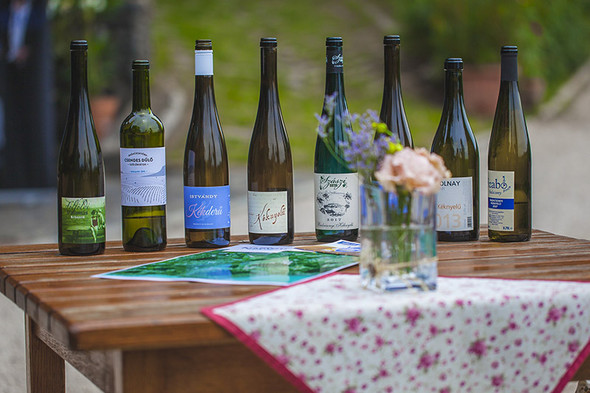Cover pic: Attila Papp
Badacsony has to be one of my favourite Hungarian wine regions and I rarely turn down the opportunity for a visit. I love to see the black basalt hill and its characteristic sibling hills and cones fringed with verdant vines rising from the surrounding landscape or looming over the Balaton.
In this case, it was the chance to participate in what the Hungarians call an ‘origó’ tasting, i.e. a tasting to determine the benchmark style for a variety and see how individual wines deviate from this, whether they be thinner and lacking in varietal character or more full-bodied and dense than you would normally expect.

Istvándy Estate by Attila Papp
So, why was this tasting taking place? And what exactly is Kéknyelű? Just another Hungarian tongue twister like Cserszegi Fűszeres?
Well, in the last twenty years or so, many wine drinkers have bored of the endless tide of international varieties from all corners of the world and are seeking something different and more exciting to explore and indulge in. I’m sure you’re all familiar with the expression ‘ABC’ – anything but Chardonnay; this is a perfect reflection of the desire to drink something other than what can be found everywhere. Regions around the world increasingly seek to highlight their own particular terroir and underline what they feel it can bring to a wine (although the fact that you can actually feel the soil in the wine is disputed – but let’s leave that for another time). Of course, it’s also an opportunity to showcase indigenous grape varieties and to offer, so to speak, a unique selling point for the region – something you can’t find anything else. Countries like Georgia, Italy and Portugal can boast of how many indigenous varieties they possess and are beginning to capitalise on that advantage.
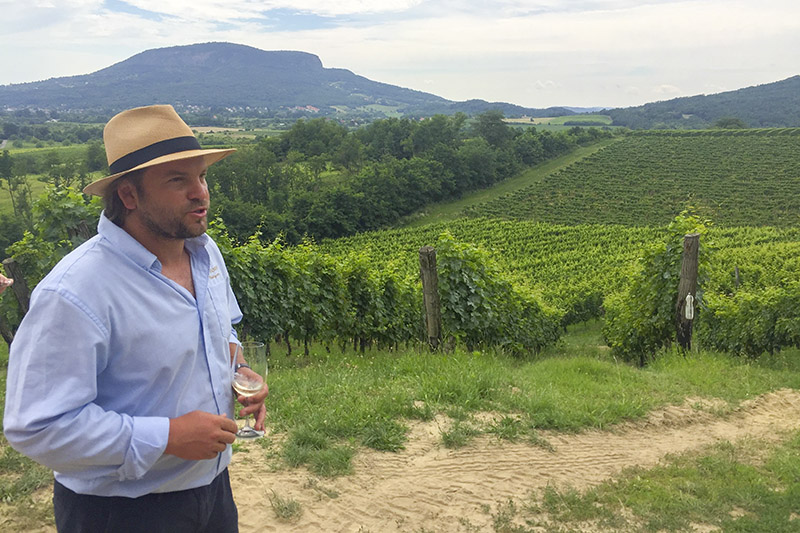
Gergő Istvándy in his vineyard by Daniel Ercsey
Hungary can do this too – it has plenty of autochthonous varieties and local styles of its own and its regions are beginning to carve out ‘brands’ for themselves with their local varieties and historic styles. Tokaj has its unique luscious botrytised wine, aszú, with its historic renown, and its dry styles of Furmint are also increasingly garnering international acclaim. The country’s smallest region, Somló, Badacsony’s twin basalt butte on the plain to the north of the Balaton, has Juhfark, its characteristic variety. Szekszárd has decided to focus on the red varieties Kadarka and Kékfrankos and its Bikavér blend, Eger naturally has its Bikavér too and its white pair Egri Csillag, and Villány, long renowned for its full-bodied Bordeaux blends and more recently for its Cabernet Franc has also launched a youthful, fruity take on Portugieser, called ‘RedY’.
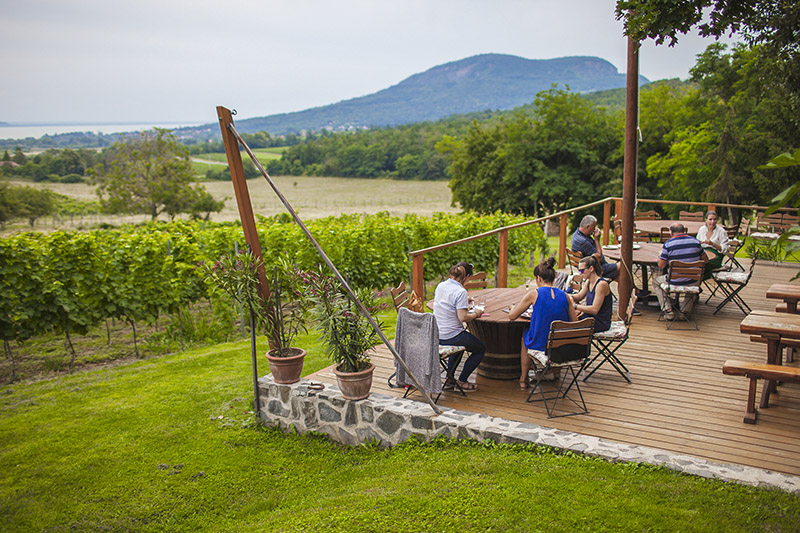
Istvándy Estate, terrace by Attila Papp
And what of Badacsony? Well, it lies on the northern shore of the Balaton, so it’s also part of the Olaszrizling BalatonBor initiative, along with Csopak – perhaps best known for its successful efforts with the variety – and the other regions around the Balaton. However, Badacsony has another trump card to play and that is Kéknyelű. A rather fickle variety that is only present in the region; it’s difficult to grow as it only has female flowers and needs another variety, such as Budai Zöld or Rózsakő (in our host and the tasting’s organiser, Istvándy’s, case, which he incidentally also thinks has good potential) to be cross-planted to aid pollination. It’s a notoriously low yielder; thus, an unwelcome variety in times of mass production such as the country saw post WWII. The variety’s name means ‘blue-stemmed’ and comes from its red-blue stems. Kéknyelű actually enjoyed great prestige at the end of the nineteenth century when it was a well-known and loved variety in the country, yet around ten years ago, Gergely Istvándy tells us, there was only around 1 hectare of the variety left in the region, although this has now grown to 46 hectares. The 1420-hectare Badacsony region itself is now also gaining in strength again with an increasing number of established wineries producing quality wines, so Gergely believes the time is ripe to pull the region’s ace from up its sleeve and bring Kéknyelű to the world’s attention.
This was the catalyst for this tasting. Growing numbers of wineries are producing wines from Kéknyelű, yet there is no uniform style as yet; each wine has its own clear characteristics and own uniqueness. However, if the wine region would really like to set Kéknyelű in stone as its flagship variety and given that they already have their own bottle (Rhine Riesling-style) which some producers are using, they urgently need to find a uniform style so that consumers know what to expect when they are buying or ordering a Kéknyelű, a little-known variety nowadays, even in Hungary.
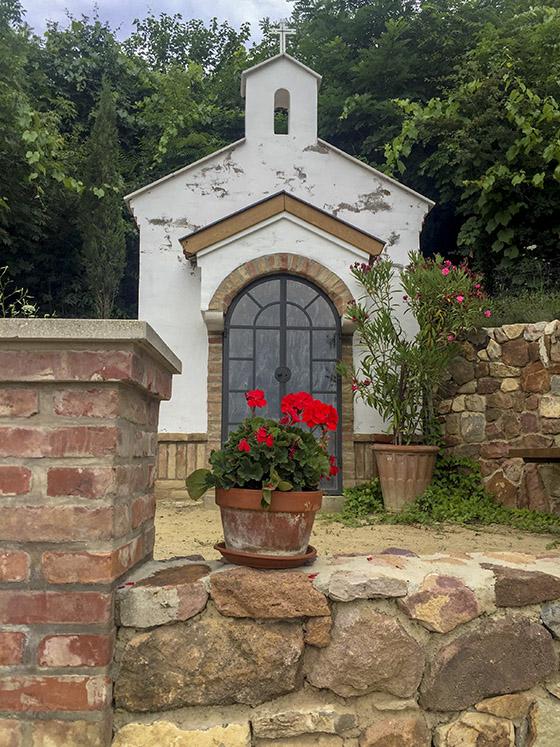
Small chapel in the vineyard by Daniel Ercsey
The tasting gathered together around 30 seasoned palates, mostly Badacsony winemakers but also some journalists and WSET diploma holders, to taste 28 Kéknyelű, from 24 winemakers and several vintages and to try to formulate what Kéknyelű is.
Well, thanks to previous experience and various books, I knew that it is a variety with attractive acidity which can make full-bodied wine but has no clear style; that it can produce savoury, smoky wine with hints of gunpowder, lemon, stone fruits, white blossom, herbs, oiliness and the minerality characteristic of Badacsony’s basalt terroir; and that although it’s very drinkable when young, its high acidity means that it comes into its own after a few years, developing attractive honeyed nuttiness with bottle age.
So, was this borne out by the tasting? To a certain extent, yes.
We tasted wines from 2017, 2016, 2015 and 2013 as well as two older Kéknyelű from 2006 and 2000. After tasting the 2017s, two clear styles emerged – a fresh reductive style and an oak-aged version, raising the question of whether the region should offer two styles – a Classic (reductive) and Premium (oaked) style. However, András Horkay, Director of the Central European Wine Institute (CEWI), who presided over the tasting, warned against using too much oak and attempting to make big, full-bodied wines masking varietal character. There was general agreement that the wines had high acidity, relatively high alcohol and were medium-bodied with aromas of white blossom, lemon and lime. Flavours ranged through white apple, white peach, stoniness and oiliness with some having a herbal streak and chamomile note. However, there was a great deal of variation in style, likewise in 2016.
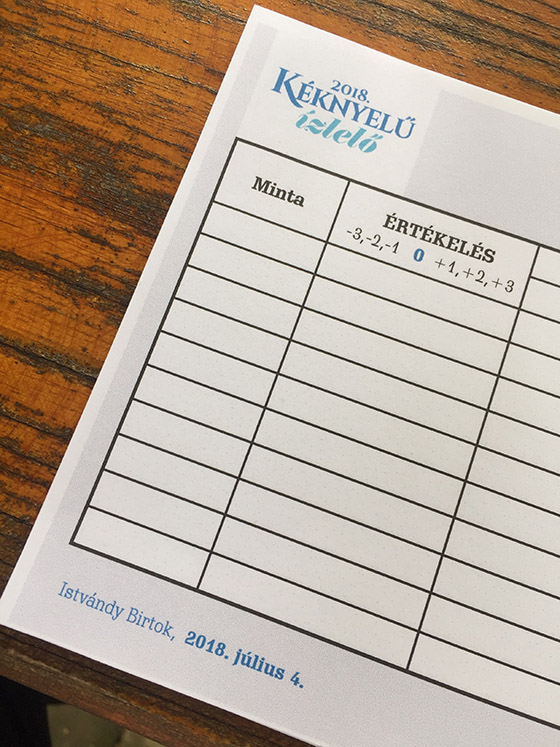
Photo: Daniel Ercsey
The wines from 2015 and 2013 had greater complexity and more scored closer to the benchmark (0) in both years, hence demonstrating increasing uniformity in style. Most tasters agreed that they preferred these wines with the additional years of bottle ageing, upholding what I had also thought beforehand. Indeed, the 2006 (Szeremley) still showed remarkable freshness along with beautiful complexity. Which leads to a further question? How soon should wineries be releasing Kéknyelű – would they be better off waiting a couple of years to allow Kéknyelű to demonstrate its full potential. Should winemakers leave a touch of residual sugar to balance the high acidity and facilitate ageing?
The tasting perhaps raised as many questions as it answered. However, of the 28 wines, 8 wines scored at least 10 benchmark (0)s, showing that a style was beginning to emerge as was a certain amount of consensus as to what that should be. If you’d like to try one of the benchmark wines, you should set your sights on the 2017 Szászi, 2016 Sipos, 2015 Istvándy or 2013 Csendes. If you can get your hands on a 2006 Szeremley, and taste how the variety can age, even better.
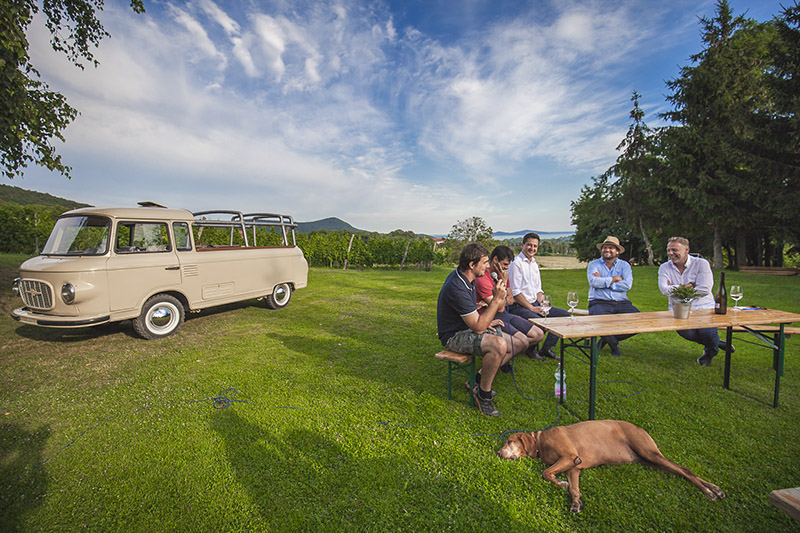
Discussion about the Kéknyelű variety with winemakers, András Horkay and Daniel Ercsey from the WineSofa by Attila Papp
The general public also had the chance to taste the Kéknyelű line-up in the evening on Gergely’s terrace with its stunning views over the vineyards with the Balaton in the distance. And, if you’d like to taste Kéknyelű in situ too, you could do worse than head there yourself – two of his wines made it into the eight benchmark wines and he also makes a lovely Kéknyelű traditional method sparkler. And if you’re lucky enough to do a vineyard tour with him, you’ll also have the chance to putt-putt, roar and speed alternately through the hills with the wind in your hair in his old Barkas transporter, now transformed into a convertible! You may also catch a glimpse of his mangalica pigs and grey cattle. The perfect way to spend an afternoon!



